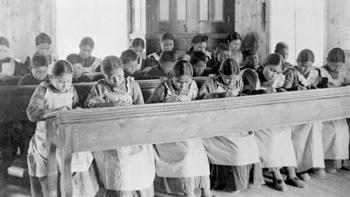As Truth and Reconciliation Commission Ends, Hard Facts about Residential Schools Remain Chilling
By Dennis Gruending
The Truth and Reconciliation Commission of Canada (TRC) will hold its closing events in Ottawa between May 31 and June 3, 2015. The TRC was established in 2008 as a part of the Indian Residential School Settlement Agreement in order to inform Canadians about the history and legacy of such schools. For more than 130 years, the institutions were operated by the government and by Canadian churches on the government's behalf. A second portion of the TRC mandate is to inspire a process leading toward reconciliation within Aboriginal families, and between Aboriginal peoples and non-Aboriginal communities, churches, governments -- and Canadians in general. Here are some facts about residential schools that shouldn't be forgotten: • In 1879, politician Nicholas Flood Davin visited the U.S. to observe residential schools and recommended them for Canada. • In 1883, Canadian government minister Hector Langevin said, "In order to educate the [Indian] children properly we must separate them from their families." • Also in 1883, the Canadian government began to provide funding to church-run residential schools. • 132 residential schools in total were created. • Residential schools did not exist in Newfoundland, New Brunswick and Prince Edward Island. • An estimated 60 per cent of church-run residential schools were operated by Roman Catholics; 25 per cent by Anglicans and 15 per cent by the United Church of Canada. Several others were operated by Presbyterians and other churches. • 150,000 children were removed from their families and communities and placed in residential schools. • More than 4,100 children died of disease or by accident while attending a residential school. • In 1920, the deputy minister of Indian Affairs predicted that within a century, Aboriginal people would cease to exist as an identifiable cultural group. • Also in 1920, the Indian Act was revised and attendance at residential schools was made compulsory for all children up to age 15. • In 1960, status Indians were first allowed to vote in federal elections. • In 1996, the last residential school was closed. • An estimated 80,000 residential school survivors were accounted for in 2012. • In 2006, Canada approved a settlement that led to a Common Experience Payment (CEP), which was made available to former residential school students. • $10,000 was given to eligible former residential school students for their first year of attendance, plus $3,000 for each additional year. • 105,457 of CEP applications have been received since 2007. • 79,272 of CEP applications were paid as of Sept. 30, 2014. • 23,892 applications have been deemed ineligible. • $1,621,295,106 of CEP payments have been distributed in total. • $20,452 is the average CEP payment. • In 2008, Prime Minister Stephen Harper issued an apology to former residential school students. • University of Manitoba is the home of the National Research Centre, which will house the statements, documents and all other materials the TRC has gathered. • Eight out of 10 respondents to a 2000 Angus Reid poll said that they were aware of the residential schools issue. • Five out of 10 respondents to a 2008 Environics poll said that they had heard or read something on the subject of residential schools. This piece appeared as a blog post for the United Church Observer on May 21, 2015.
|
.
Any original material on these pages is copyright © BishopAccountability.org 2004. Reproduce freely with attribution.
